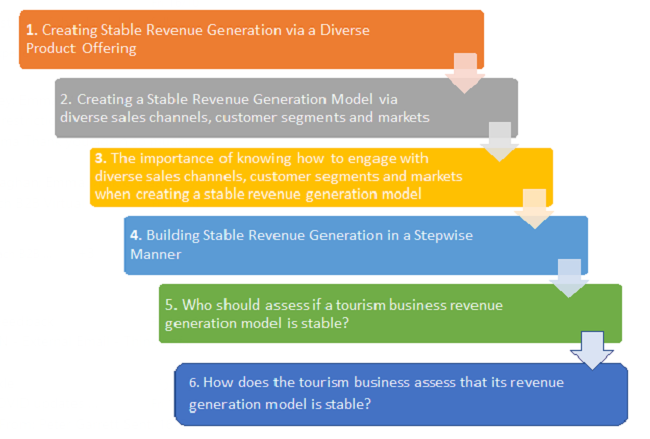Contents
- Introduction
- 1. Creating Stable Revenue Generation via a Diverse Product Offering
- 2. Creating a Stable Revenue Generation Model via diverse sales channels, customer segments and markets
- 3. The importance of knowing how to engage with diverse sales channels, customer segments and markets when creating a stable revenue generation model
- 4.Building Stable Revenue Generation in a Stepwise Manner
- 5. Who should assess if a tourism business revenue generation model is stable?
- 6. How does the tourism business assess that its revenue generation model is stable?
- Summary Notes and Conclusion
Contents
- Introduction
- 1. Creating Stable Revenue Generation via a Diverse Product Offering
- 2. Creating a Stable Revenue Generation Model via diverse sales channels, customer segments and markets
- 3. The importance of knowing how to engage with diverse sales channels, customer segments and markets when creating a stable revenue generation model
- 4.Building Stable Revenue Generation in a Stepwise Manner
- 5. Who should assess if a tourism business revenue generation model is stable?
- 6. How does the tourism business assess that its revenue generation model is stable?
- Summary Notes and Conclusion
Creating a Stable Revenue Generation Model for Your Food & Drink Business
Introduction
Through a well-planned revenue generation strategy, a tourism business defines and develops its commercial model to create an income and achieve profitability. A tourism business that brings product to market has the potential to generate revenue in three-key ways:
- Sales channels
- Direct: for example, website bookings
- Indirect: for example, tour operator bookings
- Customer segments: including families, active retired, wedding and corporate customers
- Markets: domestic and global

Once the tourism business learns how to build revenue via sales channels, markets and customer segments, the process of revenue generation begins. As revenue and profitability builds, it is most important that the tourism business avoids complacency by consistently analysing the composition of this revenue generation to ensure it is stable so that the business can thrive and survive into the future.
Stable revenue generation is based on the principle of bringing diverse products to market for a customer to purchase via diverse sales channels, markets (domestic and global) and customer segments.
As an industry, tourism is exposed to many uncertainties including economic, political and market volatility. With this in mind, consider the outcome for a business that engages in one, or a limited number of sales channels, markets and customer segments as outlined below:
- Sales channel: for example, website, or tour operator bookings?
- Market: for example, Northern Ireland counties only, or any other international market such as France, or the United States?
- Customer segment: for example, the corporate market, wedding market, or active retired market?
By being over reliant on limited sources of revenue generation, the tourism business
- exposes itself to risk by putting all its eggs in one basket
- misses potential revenue generation opportunities by not engaging in new sales channels, markets and customer segments
Businesses that are over-reliant on one, or a limited number of sales channels, markets, and/or customer segments are at high risk as external pressures may cause the limited source of revenue generation to fail.
Covid-19 makes tourism businesses keenly aware of this reality. For example, a tourism business that in the past focused solely on the following revenue generation sources, can now experience a decline in revenue when holidays from global markets are curtailed:
- Market: United States
- Customer segment: holiday maker
- Sales channel: tour operators
The global recession that happened 2007-2009 also affected tourism businesses, some of which operated the following revenue generation model:
- Market: domestic
- Customer segments: corporate and leisure individual
- Sales channel: business website
During this time, many businesses that had over-relied on the domestic market and placed an emphasis on their own business brand website found that their revenue generation plummeted once the recession had an impact on the domestic market’s disposable income.
While it is natural to feel optimistic as revenue generation flows through the tourism business, it is crucial that the tourism business knows how to protect itself by regularly assessing its revenue generation model to determine if it is stable.
A tourism business should regularly assess its revenue generation model to ensure it is stable.
In short, a stable revenue general model enables a tourism business to mitigate risk. The purpose of this document is to illustrate how a tourism business can create a stable revenue generation. This subject is explored under the following headings:
